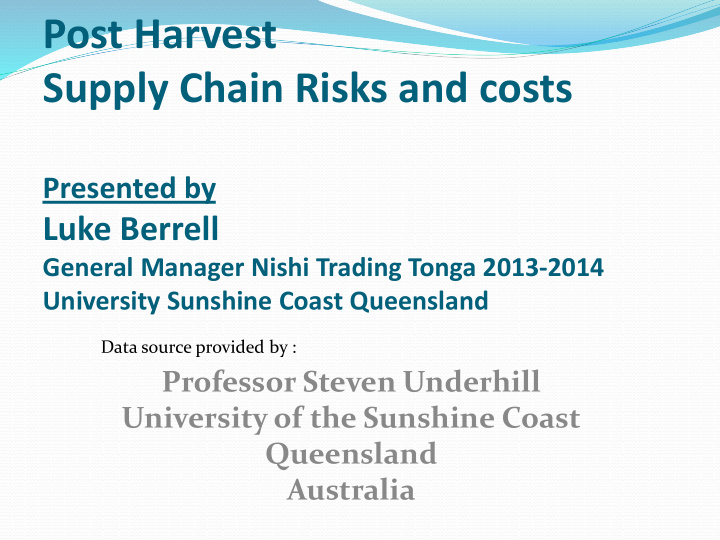



Post Harvest Supply Chain Risks and costs Presented by Luke Berrell General Manager Nishi Trading Tonga 2013-2014 University Sunshine Coast Queensland Data source provided by : Professor Steven Underhill University of the Sunshine Coast Queensland Australia
The cost of loss – example 58% loss after 4 days 4% 6.4% 11% 0.13 % thrown away failed to losses Physical Post market wastage. by vendor ripen damage due to rots during due to over- during Day 1 = 7.3 % transport ripe or rots ripening. Day 2 = 8.5% losses Day 3 = 6.2% Day 4 = 14.3% On-farm use - Animal feed . All due to rots Short and sharp supply chains • Eight hours road transport (farm to market) • All product was sold by the vendor within 30 hours (1 day’s trading) • Commercial loss = 21.4% (farm to vendor) and projected further 15.7% loss post-vendor (total = 37.1%) • Total 58% losses after 4 days of product leaving the farm
Preliminary food safety assessment It must be safe to eat. Purchased tomato from 15 different traders at the Suva markets on 28 th August. All product was grown in the Sigatoka market. Samples were assessed for E. coli (food borne pathogen and a major cause of food poisoning in human) by the USP microbiology labs.
Food safety risk factors Use of uncomposited manures Quality of the water supply Poor postharvest temperature management Animal access to fields Handling hygiene Absence of hand washing Possible truck and field crates hygiene Product in contact with the ground pre or postharvest Anticipate highest risk in lettuce and root crops.
Effect of too high and too low a temperature Source – UC Davis
Day 6 Fruit for sale at the Suva municipal markets Day 0 – pre-harvest in the field Day 1 to 4 ambient ripening Day 4 – packing in plastic boxes Day 5 (3pm ) – departs farm Day 5 (9pm) arrives at Suva
The Path to Market A
Monitoring Temperature during Transportation and storage. Note highest temp during transporting Fruit picked Truck and leaves the Truck immediately farm arrives at put in bag Suva Conditions inside the bag of eggplant, from picking to arrival.
Effect of bruising and damage during Transport and delivery Assessment of the stresses product was exposed to during transport to the market. Why is this important? Is there a need to modify packaging to reduce in-transit injury Is the loading/unloading , and the actual load configuration needing to be addressed
Navua – (1.5 hour Truck leaves farm @ Crows nest Mid west bank of stop) for Suva round about Sigatoka Valley. Truck pickups Truck at/near Navua to Suva from adjacent Naboutini road farms Truck moving Arrive and around farm unloading
Day 1 - On the truck ready to leave
Day 1 – just picked
Day 3 – Saturday
Day 5 - Monday
Thrown away due to decay – New opportunities What can we do to turn a loss into a profit. Juicing, pesto, preserves, chutneys…..domestic supply Day 6 – Disposal
Quality is…….. ...to the grower ...to the wholesaler ...to the consumer • good appearance • ease of harvesting • firmness and handling • good appearance • package robustness • good appearance • soundness/safety • long storage life • high yield • firmness • supply/demand • disease resistant • flavour • shipping ability • shipping ability • aroma • Profitable • Profitable • nutritious • Price • Taste, • High price & low appearance, wastage • Easy to grow and healthy easy to sell and safety
The new target – Supply the Tourism Market Who is your target Market – do you have what they want for the price they will pay? What does your target market expect in terms of quality? Can you supply the quantity and range, to your customers? Can you supply them consistently? What are the risks and costs to sell to this market? Will the F&B industry in Tonga pay extra $ for Quality ?
Vegetable Chain Map into Fiji Hotel & Resorts
The Fresh value chain First Pick Farm direct (Chef has exclusive access to 1. field and personally selects the produce) Pick from pack house (Chef/ purchasing officer selects 2. produce from pack house before distribution) Pack to order (customer send order, pack house packs 3. for pick up or delivery) Delivery van on circuit stopping at each establishment 4. Purchase from early morning market [approved 5. growers] (Chef/ purchasing officer browse the market for quality, variety and quantity.
Know what your customers Value 1. Advertise / promote your products and services 2. Talk and listen to your customers 3. Understand your customers – Price, quality what they like, what they want. What they don’t like. 4. Build a relationship of reliability and trust . Remember Price is not always the reason your customers returns. 4. Use this information for future cropping decisions Need to understand supply and demand. 5. When your customers are happy they will want more More Customers = More Work = More $$$
End of Post Harvest Supply Chain Risks and costs Malo Apito Luke Berrell (Nishi Trading /USC) Question To growers – what are the additional costs do you think you need to cover for this market?
Recommend
More recommend